
Wound Care Questions and Answers: A Comprehensive Guide
Navigating wound care requires informed decisions; resources from organizations like WOCN and the Wound Healing Society offer vital guidelines and support for effective management.
Accessing current, evidence-based information – such as the 2017 WOCN pressure injury guidelines and the 2006 Wound Healing Society chronic wound care guidelines – is paramount.
Partnerships, like those between Nancy Morgan Wound Care and Davis Clinical Consulting, demonstrate a commitment to comprehensive skin and wound care education and implementation.
What is a Wound? Types and Classifications
A wound represents a disruption in the normal integrity of the skin, and can extend into deeper tissues. Understanding wound types is crucial for appropriate care. Wounds aren’t simply ‘cuts’; they are diverse, ranging from superficial abrasions to complex penetrating injuries.
Classifications often center on cause: surgical wounds resulting from planned incisions, traumatic wounds from accidents, and chronic wounds, like pressure injuries or diabetic ulcers, which have a prolonged healing trajectory.
Pressure injuries (formerly bedsores) develop from sustained pressure, impacting skin and underlying tissue. Diabetic foot ulcers stem from nerve damage and poor circulation. Venous leg ulcers arise from insufficient venous return.
Wound depth further categorizes them: partial-thickness wounds affecting only the epidermis and dermis, and full-thickness wounds extending into subcutaneous tissue or deeper. Accurate classification, guided by resources like the WOCN guidelines, informs treatment strategies and predicts healing potential;
Effective wound management begins with precise identification.
How Do Wounds Heal? Stages of the Healing Process
Wound healing is a dynamic, overlapping process, not a linear one. It generally progresses through four phases: hemostasis, inflammation, proliferation, and maturation.
Hemostasis, the initial response, focuses on stopping blood loss through clotting. Inflammation follows, bringing immune cells to clear debris and fight infection – redness and swelling are hallmarks.
The proliferative phase involves rebuilding tissue: new blood vessels form (angiogenesis), and collagen is deposited to create a wound bed. Granulation tissue appears, signaling progress.
Finally, maturation (remodeling) strengthens the wound, with collagen reorganization and scar formation. This phase can take months or even years.
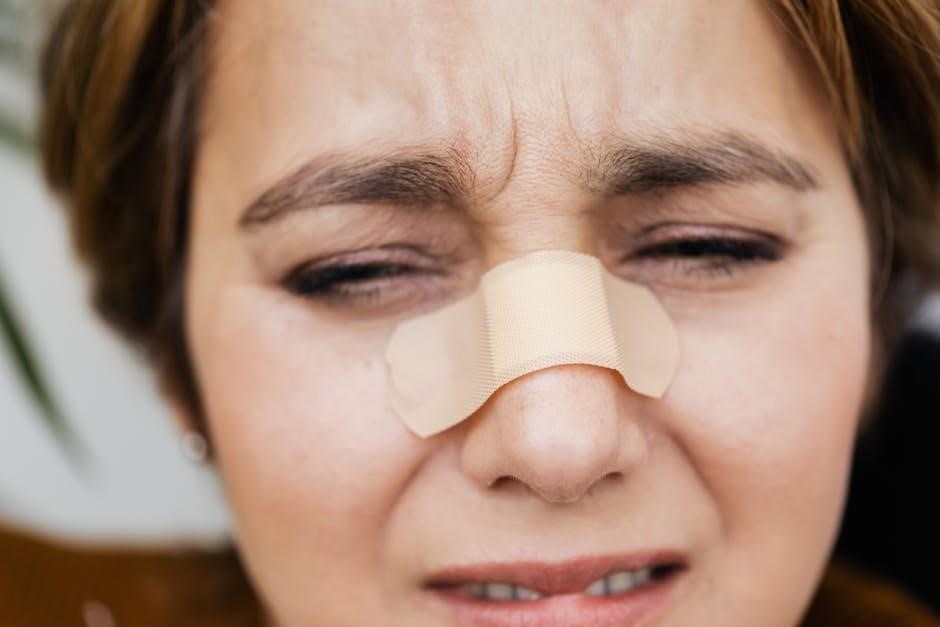
Factors like nutrition, blood supply, and infection status significantly impact healing. Evidence-based guidelines from organizations like the Wound Healing Society emphasize optimizing these factors for successful wound closure.
Understanding these stages is key to targeted interventions.
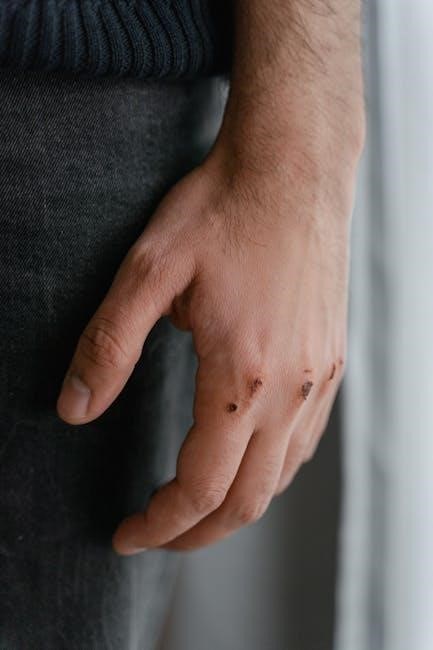
Common Wound Types & Specific Care
Diverse wound types necessitate tailored approaches; pressure injuries, diabetic ulcers, venous leg ulcers, and surgical wounds each demand unique assessment and management strategies for optimal healing.
Pressure Injuries (Bedsores/Pressure Ulcers): Prevention & Stages
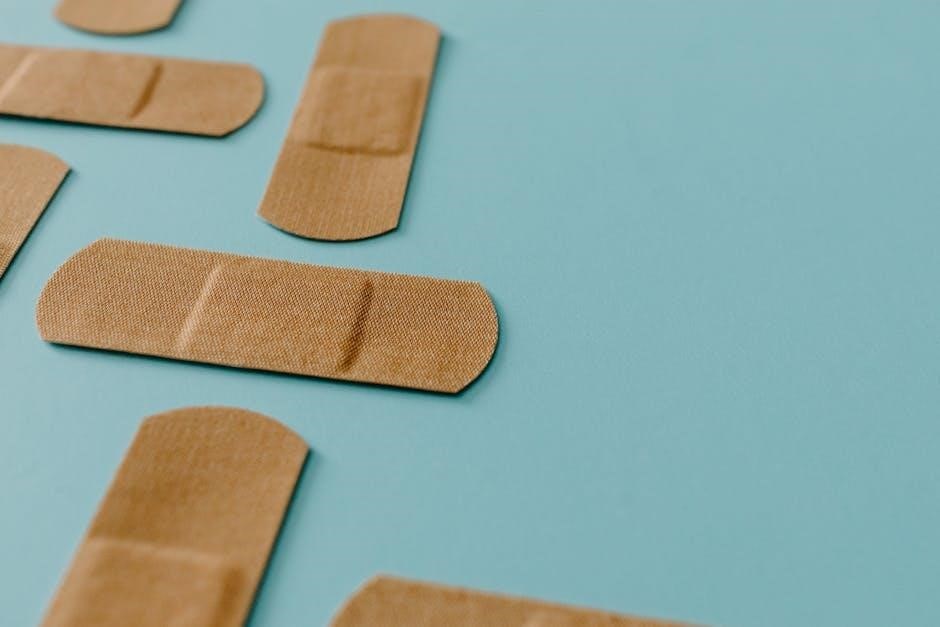
Pressure injuries, commonly known as bedsores or pressure ulcers, develop when sustained pressure compromises blood flow to the skin. Prevention is paramount, involving frequent repositioning, meticulous skin care, and pressure-redistributing surfaces.
The WOCN (Wound, Ostomy and Continence Nurses Society) 2017 guideline emphasizes a multi-faceted approach to prevention, focusing on risk assessment and individualized care plans.
Staging classifies the severity: Stage 1 involves non-blanchable redness; Stage 2 presents with skin breakdown; Stage 3 extends into subcutaneous tissue; Stage 4 reaches muscle or bone.
Unstageable injuries have obscured depth, and deep tissue injuries show purple or maroon discoloration.
Effective management includes offloading pressure, wound cleansing, appropriate dressings, and nutritional support. Early intervention significantly improves outcomes and minimizes complications.
Consistent monitoring and documentation are crucial for tracking progress and adjusting the care plan as needed.
Diabetic Foot Ulcers: Unique Challenges & Management
Diabetic foot ulcers pose significant challenges due to impaired circulation, neuropathy, and increased susceptibility to infection; These ulcers often develop on pressure points, frequently on the soles of the feet.
Effective management requires a comprehensive approach, including strict blood glucose control, offloading pressure through specialized footwear or total contact casts, and meticulous wound care.
Debridement of necrotic tissue is crucial to promote healing, while appropriate dressings maintain a moist wound environment and protect from infection.
Regular assessment for signs of infection – redness, warmth, swelling, and purulent drainage – is essential, potentially requiring antibiotic therapy.
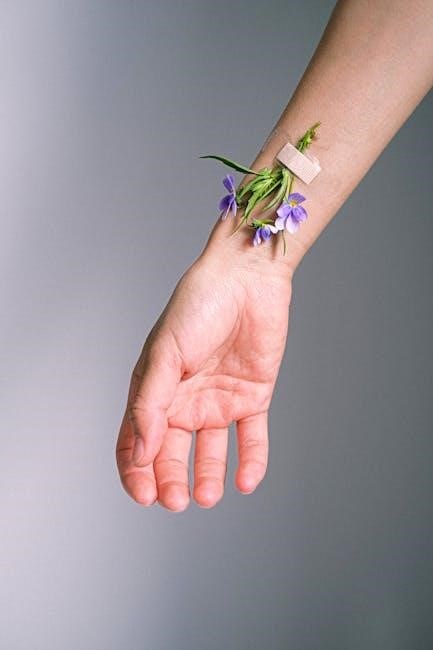
Patient education regarding foot care, including daily inspection and proper footwear, is vital for prevention.
Collaboration with a multidisciplinary team – including podiatrists, endocrinologists, and wound care specialists – optimizes outcomes and reduces the risk of amputation.
Venous Leg Ulcers: Causes, Symptoms & Treatment Approaches
Venous leg ulcers develop due to chronic venous insufficiency, where valves in leg veins fail, leading to blood pooling and increased pressure. This pressure damages skin and tissues, resulting in ulcer formation, typically around the ankles.
Symptoms include pain, swelling, itching, and visible ulcers often with irregular borders. Skin discoloration and hardening are also common.
Treatment focuses on improving venous circulation and promoting wound healing. Compression therapy, using graduated compression stockings or wraps, is fundamental to reduce swelling and pressure.
Wound care involves cleansing, debridement, and appropriate dressings to maintain a moist environment and prevent infection.
Elevation of the legs also aids in reducing swelling.
In some cases, interventions like vein ablation or surgical repair may be considered to address the underlying venous insufficiency and prevent ulcer recurrence.
Surgical Wound Care: Post-Operative Instructions & Monitoring
Post-operative wound care is crucial for optimal healing and infection prevention. Patients should receive clear instructions regarding wound cleansing, dressing changes, and signs of complications.
Keep the incision clean and dry, following the surgeon’s specific recommendations. Gentle cleansing with mild soap and water is usually advised.
Dressings should be changed as directed, monitoring for increased redness, swelling, drainage, or pain – indicators of potential infection.
Avoid strenuous activity and heavy lifting for a specified period to prevent wound disruption.
Monitor for fever, chills, or increased pain, and report any concerns to the healthcare provider immediately.
Proper nutrition and hydration are essential to support the healing process.
Regular follow-up appointments allow the surgeon to assess wound healing and address any issues promptly, ensuring a successful recovery.

Wound Assessment: Key Questions to Ask
Thorough assessment is vital; consider wound measurement, bed characteristics (color, tissue, exudate), and pain levels for effective care planning and monitoring progress.
Wound Measurement: Techniques for Accurate Tracking
Consistent and accurate wound measurement is fundamental to evaluating healing progress and tailoring treatment plans effectively. Several techniques are employed, each with its advantages. Traditional methods involve using a ruler to measure length, width, and depth, documenting these dimensions regularly. However, this can be subjective and prone to inter-observer variability.
More advanced techniques include wound tracing – outlining the wound on transparent film and measuring the area using graph paper or digital planimetry. Digital wound measurement tools, utilizing photographs and specialized software, offer increased precision and reduce subjectivity. These systems often calculate wound area, volume, and percentage change over time.
Regardless of the method chosen, standardization is key. Always measure to the edges of the wound bed, not including slough or eschar. Documenting the technique used ensures consistency and allows for meaningful comparisons over time. Regular measurement, ideally weekly or bi-weekly, provides valuable data for assessing treatment effectiveness and adjusting care as needed. Accurate tracking informs clinical decision-making and optimizes patient outcomes.
Wound Bed Assessment: Color, Tissue Type & Exudate
A thorough assessment of the wound bed is crucial for determining appropriate treatment strategies. Evaluating color, tissue type, and exudate characteristics provides vital clues about the wound’s healing potential. Red wound beds generally indicate granulation tissue, a sign of healthy healing, though excessive redness may suggest inflammation.
Yellow or tan tissue often signifies slough – dead cells and debris – which can impede healing. Black or brown tissue indicates eschar, devitalized tissue that must be removed to promote granulation. Assessing tissue percentage (e.g., % granulation, % slough, % eschar) provides a quantifiable measure of wound health.
Exudate, or wound drainage, varies in color, consistency, and amount. Serous exudate is clear and watery, while purulent exudate is thick and may indicate infection. Monitoring exudate levels helps determine the need for different dressing types and identifies potential complications. Comprehensive documentation of these characteristics is essential for effective wound management.
Pain Assessment: Evaluating & Managing Wound-Related Pain
Accurate pain assessment is paramount in wound care, as pain significantly impacts quality of life and healing. Utilize validated pain scales – numerical, visual analog, or descriptive – to quantify pain intensity. Consider pain characteristics: sharp, burning, aching, throbbing, and its impact on function and sleep.
Pain can arise from the wound itself, surrounding tissues, or associated treatments like dressing changes. Non-pharmacological interventions – positioning, relaxation techniques, and distraction – can provide relief. Pharmacological options include analgesics, ranging from over-the-counter pain relievers to prescribed opioids, based on pain severity.
Regularly reassess pain levels after interventions to evaluate effectiveness. Proactive pain management, anticipating pain during procedures, is crucial. Comprehensive documentation of pain assessments and interventions is essential for optimal patient care and improved outcomes.
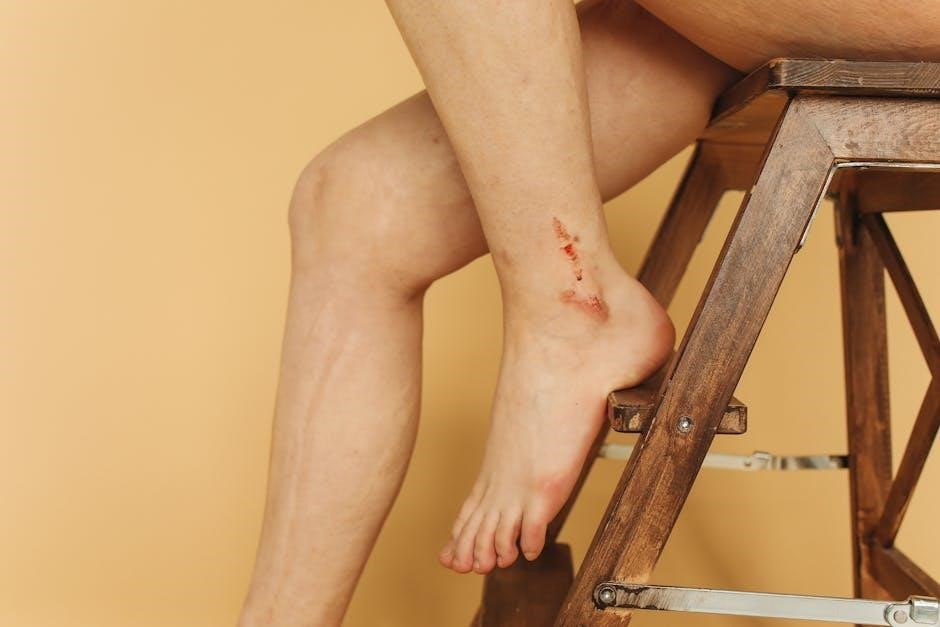
Wound Care Products & Dressings
Selecting appropriate dressings – foam, hydrocolloid, or alginate – depends on wound characteristics like exudate level and tissue type, optimizing the healing environment.
Choosing the Right Dressing: Factors to Consider
Selecting the optimal wound dressing is a critical component of effective wound management, demanding a thorough assessment of several key factors. Wound depth, size, and location significantly influence dressing choice; deeper wounds may require dressings that maintain a moist wound bed and promote granulation tissue formation.
The amount of exudate – ranging from minimal to heavily draining – dictates the absorbency capacity needed. Wound bed characteristics, including the presence of necrotic tissue, granulation tissue, or epithelialization, also guide selection. Patient factors, such as allergies, skin sensitivity, and overall health status, must be considered to prevent adverse reactions.
Frequency of dressing changes impacts both patient comfort and healthcare resource utilization. Cost-effectiveness is also a practical consideration, balancing dressing performance with budgetary constraints. Adherence to established guidelines, like those from the Wound, Ostomy and Continence Nurses Society (WOCN), ensures evidence-based practice and optimal patient outcomes. Ultimately, a holistic approach, integrating these factors, leads to the most appropriate dressing selection.
Foam Dressings: Uses and Benefits
Foam dressings are highly versatile and widely utilized in wound care, offering a range of benefits for various wound types. Their primary function is to absorb exudate, creating a moist wound environment conducive to healing. Polyurethane foam dressings are particularly effective for wounds with moderate to heavy drainage, protecting the periwound skin from maceration.
Foam’s conformability allows it to fill dead space, promoting granulation tissue formation in deeper wounds. Different foam formulations exist, including those with adhesive borders for secure application and those impregnated with silver for antimicrobial properties. They are suitable for pressure injuries, leg ulcers, and surgical wounds.
Foam dressings provide thermal insulation and cushioning, reducing pain and discomfort. Following guidelines from organizations like WOCN ensures appropriate selection and application. Regular monitoring is crucial to assess exudate levels and dressing integrity, optimizing healing outcomes.
Hydrocolloid Dressings: Applications and Considerations
Hydrocolloid dressings create a moist wound environment by interacting with wound exudate to form a gel. This gel maintains optimal moisture levels, promoting autolytic debridement – the body’s natural process of removing dead tissue. They are particularly well-suited for shallow to moderately deep wounds with low to moderate exudate, such as pressure injuries (stages I & II) and superficial burns.
Hydrocolloids offer a degree of occlusion, protecting the wound from external contamination and trauma. However, they are not ideal for heavily exuding wounds, as this can lead to leakage and maceration. Careful assessment of exudate levels is crucial for appropriate selection.
Following WOCN guidelines ensures proper application and monitoring. Considerations include the dressing’s adhesive properties and potential for allergic reactions. Regular inspection is necessary to evaluate the gel formation and ensure the dressing remains intact, supporting optimal wound healing.
Alginate Dressings: For Highly Exuding Wounds
Alginate dressings are derived from seaweed and possess a remarkable ability to absorb significant amounts of wound exudate, forming a gel-like substance. This makes them exceptionally well-suited for managing highly exuding wounds, such as heavily draining pressure ulcers, traumatic wounds, and post-surgical sites with substantial drainage.
The gel formation maintains a moist wound environment while effectively controlling fluid levels, preventing maceration of the surrounding skin. Alginates also offer hemostatic properties, aiding in controlling bleeding. Following established wound care guidelines, like those from the Wound Healing Society, is crucial for optimal use.
Considerations include the need for a secondary dressing to secure the alginate and manage any remaining moisture. Regular monitoring is essential to assess absorption capacity and ensure timely dressing changes, promoting efficient wound healing.

Preventing Wound Infections
Diligent infection prevention is key; proper hand hygiene, recognizing infection signs, and judicious antibiotic use – guided by WOCN and Wound Healing Society guidelines – are vital.
Recognizing Signs of Infection: What to Look For
Early detection of wound infection is crucial for preventing complications and ensuring effective healing. Vigilant monitoring for specific indicators is paramount. Look for changes in the wound bed, such as increased redness extending beyond the wound edges, or the development of warmth around the site.
Increased pain, disproportionate to the wound size or stage, is a significant warning sign. Changes in wound exudate – specifically, a shift to thicker, purulent drainage (pus), or an increase in the amount of drainage – should prompt immediate attention. Note any unusual odor emanating from the wound.
Systemic signs of infection, though less common in localized wound infections, can indicate a more serious condition. These include fever, chills, and general malaise. Consult established guidelines from organizations like the Wound, Ostomy and Continence Nurses Society (WOCN) for comprehensive information on identifying and managing wound infections. Prompt assessment and intervention, guided by these resources, are essential for optimal patient outcomes.
Proper Hand Hygiene: A Crucial Step in Wound Care
Maintaining impeccable hand hygiene is the cornerstone of preventing wound infections. It’s a non-negotiable practice for anyone involved in wound care, from healthcare professionals to family caregivers. Thorough handwashing significantly reduces the risk of introducing harmful microorganisms to the wound site.
The Centers for Disease Control and Prevention (CDC) recommends washing hands with soap and water for at least 20 seconds. Ensure all surfaces of the hands are covered, including the backs, between fingers, and under nails. If soap and water are unavailable, use an alcohol-based hand sanitizer containing at least 60% alcohol.
Hand hygiene should be performed before and after any direct contact with the wound or surrounding area, and after removing gloves. Adhering to these simple yet vital practices, supported by guidelines from organizations like WOCN, dramatically minimizes the potential for contamination and promotes optimal wound healing. Consistent practice is key.
Antibiotic Use in Wound Care: Guidelines & Considerations
Antibiotics are not routinely recommended for wound care and should be reserved for instances of confirmed infection, not simply as a preventative measure. Overuse contributes to antibiotic resistance, a growing global health threat. Appropriate antibiotic selection, if necessary, should be guided by wound cultures and sensitivity testing.
The Wound Healing Society’s Chronic Wound Care Guidelines emphasize a focus on optimizing wound bed preparation and infection control measures before considering systemic antibiotics. Topical antibiotics may be considered for localized infections, but their use should be carefully evaluated.
Healthcare professionals must adhere to evidence-based guidelines and consider the patient’s overall health status when making decisions about antibiotic therapy. WOCN resources provide valuable insights into appropriate antibiotic stewardship in wound care, promoting responsible use and minimizing adverse effects.

Resources & Further Information

Explore the WOCN (Wound, Ostomy and Continence Nurses Society) and the Wound Healing Society for comprehensive guidelines, publications, and expert insights into advanced wound care.
Access the 2017 WOCN pressure injury guidelines and the 2006 Wound Healing Society’s chronic wound care guidelines for evidence-based practices.
Wound, Ostomy and Continence Nurses Society (WOCN)
The Wound, Ostomy and Continence Nurses Society (WOCN) stands as a pivotal resource for healthcare professionals dedicated to optimizing patient outcomes in wound, ostomy, and continence care. WOCN provides a wealth of evidence-based guidelines, educational programs, and certification opportunities designed to elevate the standard of care.
Specifically, their 2017 guideline for the prevention and management of pressure injuries (ulcers), published in the Journal of Wound Ostomy & Continence Nursing, offers a comprehensive framework for clinicians. This guideline, an executive summary of more extensive work, details best practices for risk assessment, prevention strategies, and treatment protocols.
WOCN’s commitment extends to continuous learning, offering resources that address evolving challenges in wound care. Their focus on standardized approaches and collaborative practice fosters improved patient safety and quality of life. Accessing WOCN resources ensures practitioners remain at the forefront of advancements in this specialized field, ultimately leading to better wound healing outcomes.
Further exploration of WOCN’s offerings is highly recommended for anyone involved in wound management.
Chronic Wound Care Guidelines (Wound Healing Society)
The Wound Healing Society (WHS) provides crucial guidance for managing complex chronic wounds, offering comprehensive guidelines developed through rigorous research and expert consensus. Their 2006 Chronic Wound Care Guidelines, published in Wound Rep Reg, represent a landmark contribution to the field, though continually evolving with new evidence.
These guidelines, abridged versions of which are available, cover a broad spectrum of topics, from initial wound assessment to advanced treatment modalities. They emphasize a holistic approach, considering factors beyond the wound itself, such as patient comorbidities and overall health status.
The WHS guidelines were generously supported by contributions from Bernatchez and 3M, highlighting the collaborative nature of advancing wound care. Clinicians can utilize these resources to implement evidence-based practices, optimize healing rates, and improve patient quality of life. Staying current with WHS recommendations is essential for providing optimal chronic wound care.
Regular review of updated recommendations is strongly encouraged.